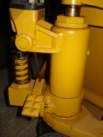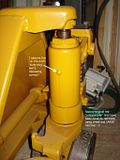the_mechanic
Aluminum
- Joined
- Sep 2, 2009
- Location
- Gainesville FL USA
I'll be corn-swoggled if I can figure where to add jack oil to this thing. saw an oil puddle under it recently. made by 'king' (whoever/wherever they are). I guess in china (no add'l info or label). bought it on ebay, can't find a manufacturers site or manual for it online. actually, have no idea of model number anyway.
I've posted five 1024 x 768 images of the 'central ram' part of this thing online, from all sides of it - clicking the tiny thumb here should open the page.

I have a multi-pallet move coming up a few days from now; -prefer- my ol' klunker jack not run out'a oil during those 'festivities' if I can help it...
ps-would some kind soul here please outline the specific topping-up, and/or air-bleeding procedure for this jack, or point me to a manual for a similar jack where it's outlined? does it fill at the 'mid ram' half-round rubber-plugged bunghole? or that big bottom bolthead?
is some arcane procedure involved, like
"jack it up fully, chock the forks UP, set the center-top handle to the fully- lowered position, THEN fill it while it's set in lowered position but WITH its forks still raised" involved, or something?
doesn't seem to be any 'jet type 65' screws up top, or whatever jet uses...
all in all, a bit baffling.
thanks guys
ps-a word to the wise, and those of you guys that might not already know:
nearly all pallet jacks sold look -very- much alike, even those sold by the same manufacturer. same color, sizes, lifting capacities, etc however they're really two types of pallet jacks, only discernable if you look *extremely* close: the serviceable kind, and the UNserviceable kind . on the UNserviceable ones, instead of using allen setscrews, etc, they do stuff like drive spring-steel rollpins driven past flush down into blind holes in the castings to secure the wheel axles, and other parts. yeah, I tried using my dent-knocker to extract 'em, no dice on that idea. my urethane tires started cracking, on the forks end. thought about it, then went ahead and chiseled 'em both right off their rims (wheel axles -not- removeable) - the urethane was turning to like a "red jelly-like" krap (there was nothing else I -could- do). a week later the steering end, more cracking, more jelly-rot, more chiseling, and a tiny bit of acetone.
so now I have a "low profile" pallet jack, but no more "jelly-rotting urethane" worries. look close in my five pix...the wheels have 'lackatire-itis', but it still lifts good, steers good, and rolls around pretty good, though not quite as quietly as it used to....
thanks for your help on the oil-fill port and tips guys
I've posted five 1024 x 768 images of the 'central ram' part of this thing online, from all sides of it - clicking the tiny thumb here should open the page.

I have a multi-pallet move coming up a few days from now; -prefer- my ol' klunker jack not run out'a oil during those 'festivities' if I can help it...

ps-would some kind soul here please outline the specific topping-up, and/or air-bleeding procedure for this jack, or point me to a manual for a similar jack where it's outlined? does it fill at the 'mid ram' half-round rubber-plugged bunghole? or that big bottom bolthead?
is some arcane procedure involved, like
"jack it up fully, chock the forks UP, set the center-top handle to the fully- lowered position, THEN fill it while it's set in lowered position but WITH its forks still raised" involved, or something?

doesn't seem to be any 'jet type 65' screws up top, or whatever jet uses...
all in all, a bit baffling.
thanks guys

ps-a word to the wise, and those of you guys that might not already know:
nearly all pallet jacks sold look -very- much alike, even those sold by the same manufacturer. same color, sizes, lifting capacities, etc however they're really two types of pallet jacks, only discernable if you look *extremely* close: the serviceable kind, and the UNserviceable kind . on the UNserviceable ones, instead of using allen setscrews, etc, they do stuff like drive spring-steel rollpins driven past flush down into blind holes in the castings to secure the wheel axles, and other parts. yeah, I tried using my dent-knocker to extract 'em, no dice on that idea. my urethane tires started cracking, on the forks end. thought about it, then went ahead and chiseled 'em both right off their rims (wheel axles -not- removeable) - the urethane was turning to like a "red jelly-like" krap (there was nothing else I -could- do). a week later the steering end, more cracking, more jelly-rot, more chiseling, and a tiny bit of acetone.
so now I have a "low profile" pallet jack, but no more "jelly-rotting urethane" worries. look close in my five pix...the wheels have 'lackatire-itis', but it still lifts good, steers good, and rolls around pretty good, though not quite as quietly as it used to....

thanks for your help on the oil-fill port and tips guys



